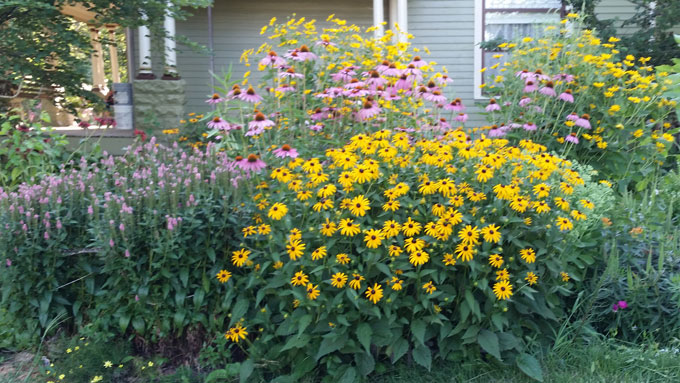Sarah Browning, Nebraska Extension Educator

Spring is a great time to divide perennials. Image by Sarah Browning, Nebraska Extension Educator.
Most perennial plants need periodic division to maintain their vigor and achieve maximum flower production. This may need to be done annually with very vigorous plants, but is usually only necessary every three to four years. Some perennials, such as Baby's Breath, Gypsophila paniculata, should never be divided.
When to Divide
The time of year when perennials are divided is a major factor in success or failure. Plants that bloom from mid-summer to fall, like chrysanthemum, aster, or purple coneflower, are best divided in the early spring before much new growth has begun. Perennials that bloom in the spring or early summer, such as peony or creeping phlox, should be divided in the fall or after the foliage dies. The exceptions to this rule of thumb are iris and daylilies, which should be divided immediately after flowering.
Perennials, especially ornamental grasses, usually develop a dead section in the center of the crown. As crown sections age, they become less active producing fewer shoots for foliage growth. New growth is produced around the edges of this inactive, center section. When that happens, it’s a good indicator your plant needs to be divided.
For more specifics on when to divide many perennial plants, refer to Iowa State University’s When to Divide Perennials.
How to Divide
To divide a perennial, first remove the plant from the soil by digging around and under the entire plant and lifting it carefully from the soil. Avoid damaging the roots as much as possible and dig up as big of a root mass as possible.
It can be helpful to remove soil around the roots by hand or with a gentle stream of water from a hose. This makes it easier to see the roots and crown, and remove old sections. But it’s not absolutely essential.
Divisions are usually taken from the outer perimeter of the plants; this area has younger, more vigorous growth. The root mass can be divided by carefully breaking it apart by hand or by cutting with a heavy sharp knife. As you work with the root mass, remove and discard any old or diseased root sections.
Cut back the top of the plant (stems, shoots and leaves) to about six inches. Divide the plant in such a way that each new division has three to five "eyes", or buds to produce new shoots. The bigger each division, the quicker they will recover and begin producing flowers again.
Replanting
If necessary now is a good time to amend your garden soil to improve drainage and structure before replanting. Spade or till 2 to 4 inches of compost into the soil, at a depth of 4 to 8 inches.
Replant the new divisions as soon as possible. Dig your holes big enough to accommodate the entire root ball without bending roots or stuffing them into a small planting hole. If the divisions have been washed so they are now bare root, then create a mound in the center of the planting hole. Place the crown at the top of the mound and drape the roots down the sides. Back fill the planting hole so the crown is at ground level. If the divisions still have soil around the roots, then place the entire division in the hole so the crown is even with ground level.
Soak plants deeply right after replanting and again 2 to 3 days later, especially if conditions are hot, windy or dry. Since a large portion of the root system has been removed during digging, special care should be taken to provide water until the plants begin to re-establish in the garden. This means at least 6 to 8 eights of weekly deep soaking when the garden doesn't get at least one inch of rain each week.
Mulch applied around perennials helps conserve soil moisture, suppress weeds and improves soil structure as it breaks down. Apply approximately 2 inches of coarse mulch around the perennials, being careful not to apply too much around the crown of the plant. Excess mulch around the crown may hold moisture in and result in increased disease problems.